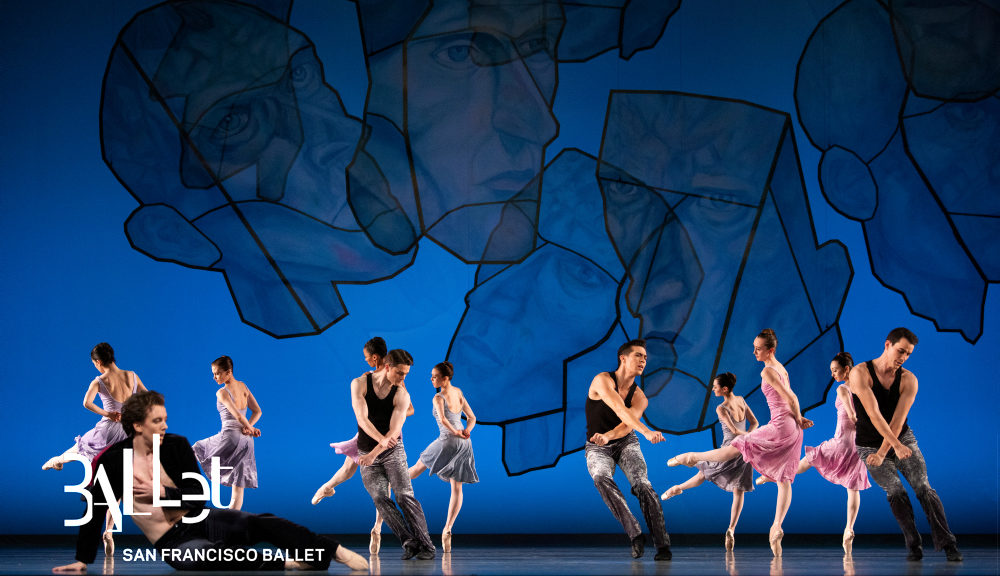
DANCING TO THE DESPOTS
Modern ballet at its most effusive marks the all-Ratmansky evening dubbed “The Shostakovich Trilogy.” In the modern mode, dancers bend, twist, lean, and go upside down, quite beyond classical ballet. And the San Francisco Ballet’s ensemble is impeccable in spinning an entire evening of Russian émigré Alexei Ratmansky’s choreography—-truly a winning combination to finish off a very rich SFB season. If at one extreme these performers can be compared to a well-tuned high-performance sports car, at the other they have to be actors in a drama.
The well-tuned part predominated in the abstract “Symphony No. 9.” No one can produce a better illusion of total weightlessness (ballon) than Ratmansky. The light-footed SFB dancers don’t move hop and jump so much as they seem to hover, unbound by gravity. And while high-leaping Wei Wang appears to float off into space, the ladies like Jennifer Stahl and Dores André are reflective, yearning for the unattainable.
A rare emphasis on acting ability evolved in “Chamber Symphony,” the most haunting of the works. The central male (on May 7, Ulrik Birkkjaer) is a tormented John Q. Public punching bag of The System and The Overseers, repeatedly on the verge of collapse. The heavy mood produced by the music is lightened with three female dancer-actresses who in turn play coquette or confidante interacting with him, ambiguous as to which side they represent (Mathilde Froustey, Sasha de Sola, Yuan Yuan Tan).
If this begins to resemble the oppression of Shostakovich’s USSR, you guessed it. This is a powerful protest piece in which the composer played the notes corresponding to his name over and over again, to indicate that this message is extremely deep-felt (though he dared not be explicit or he’d have been packed off to a gulag). Ratmansky’s “Chamber Symphony” may well be the most political work ever at SFB in the Tomasson era.
Background: Dmitri Shostakovich (1906-1975) lived most of his life under the strict artistic repression of the Soviet-Communist leadership that shot many independent thinkers and sent countless untrusted citizens to the gulag, which was often a sentence of slow death. The persecuted composer, who for years expected to be shot any day, was officially reprimanded more than once, and he clearly feared being packed off to Siberia. Protests had to be subliminal, like Shostakovich’s consistently buried within the musical notes that commissars could neither detect nor decipher. We have to view him as one of the most courageous composers ever to hit the world scene.
Ratmansky’s “Chamber Symphony” portrays a dazed man in the street barely surviving, within a regimented society where no one can be trusted. With anything less than four prime dancer-actors, this could not be carried off.
Among the wonders of this haunting piece are the ominous and enigmatic giant faces on the background, conceived by Designer George Tsypin.
The finale of the trilogy, “Piano Concerto No. 1,” sports the brilliant two-color trompe-l’oeil costumes by Keso Dekker, flashing like a whole new team with every rotation.
The SFB ensemble never looked better. And apart from some heavy going in the concerto, the SFB Orchestra under Martin West was unassailable. This trilogy will resonate long after the SFB yields up the War Memorial stage for the summer-season return of the S.F. Opera.
BALLET NOTES—Formerly in the artistic team of the Bolshoi Ballet, the inventive choreographer Ratmansky is now artist in residence at American Ballet Theatre in NYC….SFB fans missing Frances Chung and Sarah Van Patten these days would want to know that both are about to give birth.
San Francisco Ballet, all-Ratmansky program “The Shostakovich Trilogy.” Opera House, S.F., through May 12. For info: (415) 865-2000, or go online.